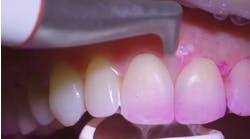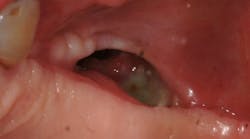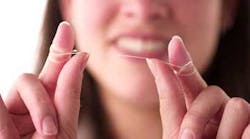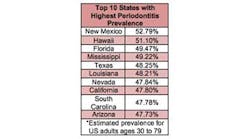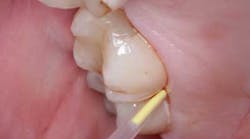Poor oral health linked to cancer-causing oral HPV infection
Aug. 23, 2013
Poor oral health, including gum disease and dental problems, was found to be associated with oral human papillomavirus (HPV) infection, which causes about 40% to 80% of oropharyngeal cancers, according to a study published in Cancer Prevention Research, a journal of the American Association for Cancer Research. “Poor oral health is a new independent risk factor for oral HPV infection and, to our knowledge, this is the first study to examine this association,” said Thanh Cong Bui, DrPH, postdoctoral research fellow in the School of Public Health at the University of Texas Health Sciences Center in Houston. “The good news is, this risk factor is modifiable — by maintaining good oral hygiene and good oral health, one can prevent HPV infection and subsequent HPV-related cancers.” The researchers found that among the study participants, those who reported poor oral health had a 56% higher prevalence of oral HPV infection, and those who had gum disease and dental problems had a 51% and 28% higher prevalence of oral HPV infection, respectively. In addition, the researchers were able to associate oral HPV infections with number of teeth lost.RELATED |OralID makes oral cancer detection affordable Similar to genital HPV infection, oral HPV infection can be of two kinds: infection with low-risk HPV types that do not cause cancer, but can cause a variety of benign tumors or warts in the oral cavity, and infection with high-risk HPV types that can cause oropharyngeal cancers.RELATED |Oral cancer and the human papillomavirus: Part 1RELATED |Oral cancer and the human papillomavirus: Part 2
Bui, Christine Markham, PhD, and colleagues used data from the 2009-2010 National Health and Nutrition Examination Survey (NHANES) conducted by the National Center for Health Statistics of the Centers for Disease Control and Prevention. This survey consisted of a nationally representative sample of about 5,000 people recruited each year, located in counties across the United States. The researchers identified 3,439 participants aged 30 to 69 years from NHANES, for whom data on oral health and the presence or absence of 19 low-risk HPV types and 18 high-risk HPV types in the oral cavity were available. Oral health data included four measures of oral health: self-rating of overall oral health, presence of gum disease, use of mouthwash to treat dental problems within past seven days of the survey, and number of teeth lost. They examined data on age, gender, marital status, marijuana use, cigarette smoking, and oral sex habits, among others, which influence HPV infection. The researchers found that being male, smoking cigarettes, using marijuana, and oral sex habits increased the likelihood of oral HPV infection. They also found that self-rated overall oral health was an independent risk factor for oral HPV infection, because this association did not change regardless of whether or not the participants smoked or had multiple oral sex partners. Because HPV needs wounds in the mouth to enter and infect the oral cavity, poor oral health, which may include ulcers, mucosal disruption, or chronic inflammation, may create an entry portal for HPV, said Bui. There is, however, currently not enough evidence to support this, and further research is needed to understand this relationship, he said. “Although more research is needed to confirm the causal relationship between oral health and oral HPV infection, people may want to maintain good oral health for a variety of health benefits,” said Bui. “Oral hygiene is fundamental for oral health, so good oral hygiene practices should become a personal habit.”


